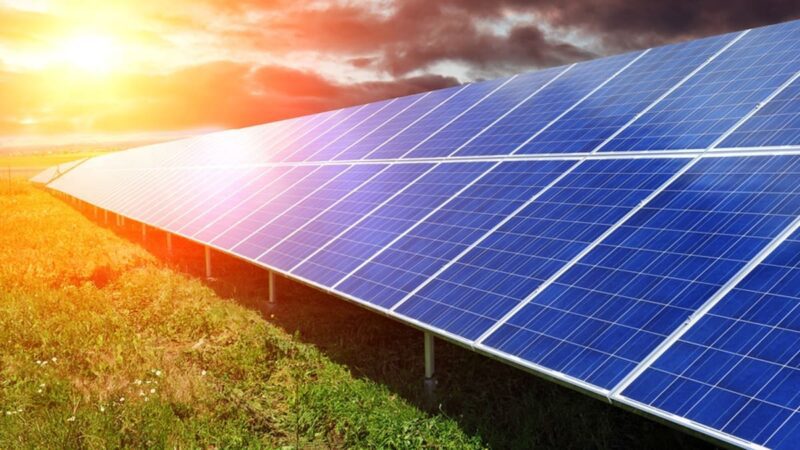Global Issues
Alternative Energy Generation In Africa; The Way Forward -By Oyetola Muyiwa Atoyebi & Ene Iwodi
Solar power is energy from the sun that is converted into thermal or electrical energy. Solar energy is the cleanest and most abundant renewable energy source available and the US has some of the richest solar resources in the world. Solar technologies can harness this energy for a variety of uses, including generating electricity, providing light or a comfortable interior environment, and heating water for domestic, commercial or industrial use.

The current deficiency with regards to electricity access in Sub-Saharan Africa (SSA) has made it a necessity to explore alternative sources of energy generation in Africa. Sources such as sunlight, wind, rain, tides, waves and geothermal heat are generally referred to as renewable energy. Shifting gears towards renewable energy as a source of energy generation could tackle the challenge of poor electricity access in Sub-Saharan Africa (SSA).
INTRODUCTION
With over 770 million people without access to electricity as of 2019, the International Energy Agency estimates that 75% of the population without access live in Sub-Saharan Africa (SSA).The SSA has the lowest access to electricity globally[1].
Africa is heavily dependent on fossil fuels such as coal, oil and natural gas to meet its energy needs. Even with the increased momentum for renewable energy, the energy mix remains insufficiently diverse due to a heavy reliance on fossil fuels, which has far-reaching negative environmental and health consequences beyond the exposure to commodity market volatility.
In the wake of the global energy transition, countries in sub–Saharan Africa will be faced with significant economic challenges due to dependence on fossil fuel commodity exports for state revenue, foreign currency reserves and local economic activity[2].
By 2050, Africa’s coal and oil energy production are expected to fall by approximately 96% and 71%, respectively[3]. This will be driven by the global decline in demand for fossil fuels, with leading international Oil and Gas companies already refocusing their portfolios to include more renewables exposure.[4] It has thus become necessary to explore alternative sources of energy generation in Africa.
Utilization of Renewable Energy
Renewable energy is one that is collected from renewable resources that are naturally replenished on a human timescale. It includes sources such as sunlight, wind, rain, tides, wavesand geothermal heat[5].
With its strong supply of wind, sunshine, hydropowerand even geothermal resources, Africa offers great potential for renewable energy deployment and investment.
Renewable energy contrasts with fossil fuels, which depletefar faster than they are replenished. Some renewable energy sources are not sustainable, despite the fact that the majority of them are, for example, Biomass, which is considered unsustainable at current rates of exploitation.
Hydropower
Hydropower is the use of falling or fast-running water to produce electricity or to power machines. This is achieved by converting the gravitational potential or kinetic energy of a water source to produce power[6]. Hydropower is a method of sustainable energy production.
Hydroelectricity is the biggest hydropower application. Hydroelectricity generates about 15% of global electricity and provides at least 50% of the total electricity supply for more than 35 countries[7].
Hydroelectric power facilities capture energy in a variety of ways. A dam and a reservoir are examples of one type. The water in the reservoir can be used to generate electricity on demand by flowing through channels that connect the dam and the reservoir. Water spins a turbine, which is linked to a generator that generates electricity.
Hydropower energy generation capacity in Africa peaked at 37.2 gigawatts (GW) in 2020. Ethiopia recorded the highest installed generation capacity of about 4GW in 2020 from 3.8GW in 2019[8].
Solar Power
Solar power is energy from the sun that is converted into thermal or electrical energy. Solar energy is the cleanest and most abundant renewable energy source available and the US has some of the richest solar resources in the world. Solar technologies can harness this energy for a variety of uses, including generating electricity, providing light or a comfortable interior environment, and heating water for domestic, commercial or industrial use.[9]
Solar energy generation capacity in Africa peaked at 10.6GW in 2020. South Africa recorded the highest installed generation capacity of about 6GW in 2020 from 4.9GW in 2019. Nigeria’s solar energy generation capacity peaked at 28 megawatts (MW) in 2020[10].
Wind Power
The use of wind turbines to generate electricity is known as wind power or wind energy. Sails, windmills, and wind pumps have all harnessed wind power in the past. Wind energy is a popular, renewable energy source that has a far lower environmental impact than burning fossil fuels. Many individual wind turbines are connected to the electric power transmission network to form wind farms.
Wind generated approximately 1800 terawatts-hour (TWh) of electricity in 2021, accounting for over 6% of global electricity.[11]
Wind energy generation capacity in Africa peaked at 6.4GW in 2019 and 2020. South Africa recorded the highest installed generation capacity of about 2.6GW in 2020[12].
Geothermal
Geothermal energy is heat within the earth. The word “geothermal’ comes from the Greek words geo (earth) and therme (heat). Geothermal energy is a renewable energy source because heat is continuously produced inside the earth. Geothermal energy is created by the slow disintegration of radioactive particles in the earth’s core, a process that occurs in all rocks.
Geothermal energy generation capacity in Africa peaked at 831 MW in 2019 and 2020. Kenya recorded the highest installed generation capacity estimated to be about 824 MW in 2019 and 2020.[13]
CHALLENGES TO ALTERNATIVE ENERGY GENERATION IN AFRICA
- Relevance on fossil fuel consumption: For Africa’s leading Oil and Gas producing countries, fossil fuels represent a vital source of energy and revenue. Shifting to an alternative generation would consequently be more difficult in countries where fossil fuels are the main source of income.
- Financing and Affordability Constraints: Renewable energy technologies have a high initial cost, which deter customers from adopting them. This also explains a large number of grants, government subsidies, and other forms of support given to renewable energy projects throughout Africa. Given Africa’s declining government revenues, this is scarcely sustainable.
- Lack of Adequate Facilities and Expertise: Many African countries lack the knowledge and technical competence to perform renewable technology research and development. This will be a major hindrance to the implementation of the use of renewable energy in Africa.
- Poor regulatory framework and Institutional arrangements: Poor regulatory regimes and Institutional arrangements involving the private sector for alternative energy (including renewables) in African countries, have stifled the ease of doing business and investments in alternative energy generation in Africa.
- Lack of Awareness: The importance of consumer education and political approval cannot be overstated. Many African countries have created policy frameworks to raise public knowledge about the benefits of renewable energy at the national level, but many of these frameworks have failed to achieve the expected results due to a lack of ability to effectively execute them at the community level.
- Economic Gap: Due to the fact that such equipment is not extensively manufactured across Africa, there is an increased reliance on the importation of solar PV and related systems. The situation is exacerbated by the imposition of high tariffs and Value-added Tax (VAT) on such commodities, which are deemed luxury items.
Recommendations
- In the impacted countries in Africa,strategies must be complemented by legislation that promotes their energy availability goals.
There will be insufficient financial and technical solutions pouring into these countries, unless good policy and legal regulatory frameworks are adhered to and implemented in energy-scarce countries.
- Strong regional Institution: Cooperation and coordination among Stakeholders including existing regional institutions is essential in addressing the issues relating to the energy sector in Africa
- Pieces of legislation that encourage foreign participation in the energy sector should be enacted. This will aid in tackling the issue of financing.
- A fair and balanced energy policy strategy must be developed, with funds earned from fossil fuel investments directed toward cleaner energy, which may eventually exceed fossil fuel dependence.
CONCLUSION
With the poor access to electricity in Sub-Saharan Africa (SSA), there is a need to address these issues arising from the energy sector. If proper legislations are enacted and adequate preparations are made, there is likely to be increased collaboration and cooperation amongst Stakeholders (project developers and utilities), in providing electricity supply via renewables.
AUTHOR: Oyetola Muyiwa Atoyebi, SAN.
Mr. Oyetola Muyiwa Atoyebi, SAN is the Managing Partner of O. M. Atoyebi, S.A.N & Partners (OMAPLEX Law Firm) where he also doubles as the Team Lead of the Firm’s Emerging Areas of Law Practice.
Mr. Atoyebi has expertise in and a vast knowledge of Corporate and Commercial Law and this has seen him advise and represent his vast clientele in a myriad of high level transactions. HeholdsthehonourofbeingtheyoungestlawyerinNigeria’shistorytobeconferredwiththerankof a Senior Advocate of Nigeria.
He can be reached at atoyebi@omaplex.com.ng
COUNTRIBUTOR: Ene Iwodi
Eneis a memberoftheCorporateandCommercialTeam OMAPLEX LawFirm. ShealsoholdscommendablelegalexpertiseinEnergy Law.
Shecanbereachedat ene.iwodi@omaplex.com.ng
[1]IEA, ‘ SDG7: Data and protection, Access to Electricity’ https://www.iea.org/reports/sdg7-data-and-projections/access-to-electricity accessed 7 April 2022
[2]PWC Africa Energy Review, 2021
[3]Ibid
[4]Ibid
[5]Ellabban, Omar; Abu-Rub, Haitham; Blaabjerg, Frede (2014). “Renewable energy resources: Current status, future prospects and their enabling technology”. Renewable and Sustainable Energy Reviews.
[6]Egré, Dominique; Milewski, Joseph (2002). “The diversity of hydropower projects”. Energy Policy
[7]Kaygusuz, Kamil (2016). “Hydropower as clean and renewable energy source for electricity production
[8] IRENA Renewable Energy Capacity Statistics 2021
[9]SEIA ‘Solar Energy’ 2022 SEIA <https://www.seia.org/initiatives/about-solar-energy#:~:text=Solar%20power%20is%20energy%20from,solar%20resources%20in%20the%20world.> accessed 7 April 2022
[10]IRENA Renewable Energy Capacity Statistics 2021
[11] Global Electricity review <https://ember-climate.org/insights/research/global-electricity-review-2022/.> accessed 7 April 2022
[12]IRENA Renewable Energy Capacity Statistics 2021
[13]IRENA Renewable Energy Capacity Statistics 2021




















